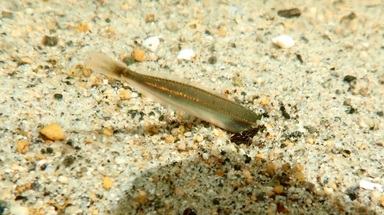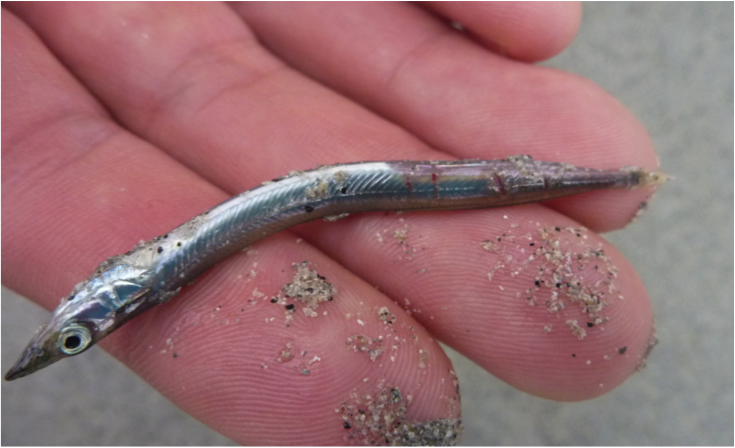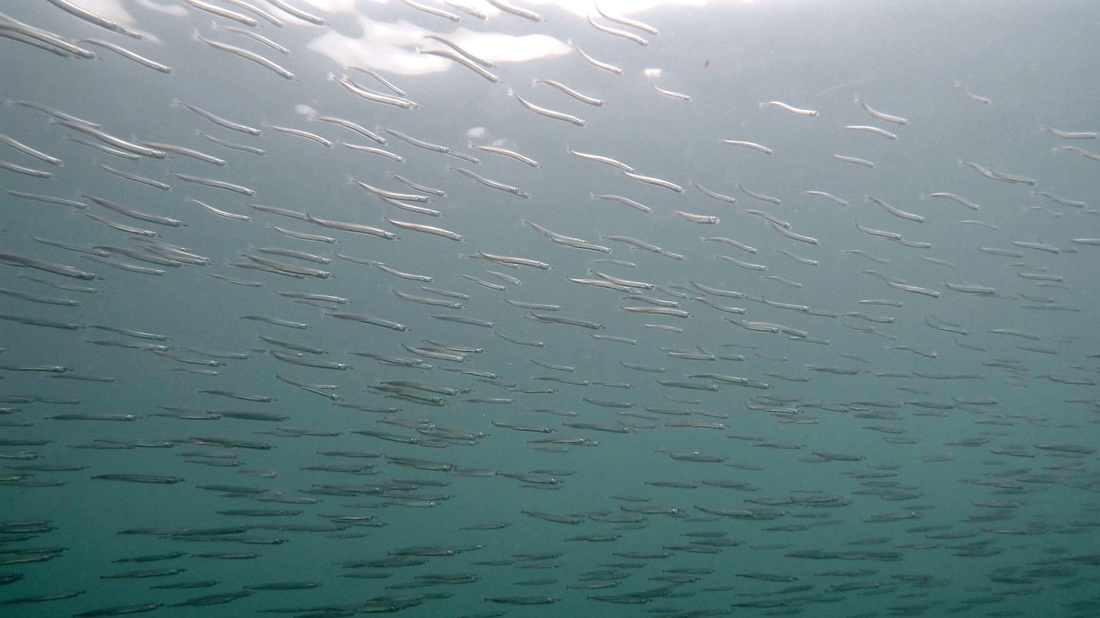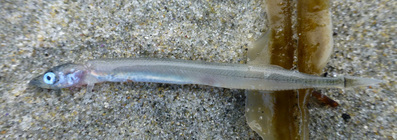Pacific sand lance • Ammodytes hexapterus
Clockwise from top left: a Pacific sand lance burying itself in sand, photographed by Kaia Bryce; a school of sand lance photographed by Tristan Blaine; dead sand lance photographed by Ian Cruickshank and David Norwell.
Identification
This forage fish has a pointed snout, elongated dorsal and anal fins, and a forked tail fin. Its long and thin body is marked by diagonal creases that create a textured effect on its iridescent silvery blue, grey or green colouring. When spawning it flashes red. Maximum length is 28 cm.
Habitat & Range
The Pacific sand lance forms schools in both nearshore and offshore waters, sometimes near wharves. It also buries in sandy and pebbly sediments. Schools and buried individuals are found in the intertidal and subtidal to 165 m deep. Schools in offshore waters stick near the surface. Spawning occurs at high tide on sand-gravel beaches. The Pacific sand lance range extends from the Aleutian Islands and Bering Sea to southern California, as well as along the Arctic Ocean from Alaska to Hudson Bay and along the western Pacific coastlines to the Sea of Japan.
Human Uses
Though small, the Pacific sand lance is edible and can be quite tasty. It is often eaten dried, salted, or fried. One recommendation is to coat sand lance in flour and fry them whole in butter (Lamb and Edgell). It is also caught for use in fishmeal. Its role as a key prey item for larger commercially- and recreationally-targeted fish make it indirectly important to fisheries.
Intriguing Info
Pacific sand lance are prey for a variety of bird, fish, and marine mammal species. Foreshore development can damage Pacific sand lance spawning habitat; impacts on sand lance spawning habitat can domino to affect the many species that rely heavily on sand lance, whether directly or indirectly.
Click here to learn about forage fish research at the Hakai Institute on Calvert Island.
iNaturalist
https://www.inaturalist.org/taxa/130238-Ammodytes-hexapterus
This forage fish has a pointed snout, elongated dorsal and anal fins, and a forked tail fin. Its long and thin body is marked by diagonal creases that create a textured effect on its iridescent silvery blue, grey or green colouring. When spawning it flashes red. Maximum length is 28 cm.
Habitat & Range
The Pacific sand lance forms schools in both nearshore and offshore waters, sometimes near wharves. It also buries in sandy and pebbly sediments. Schools and buried individuals are found in the intertidal and subtidal to 165 m deep. Schools in offshore waters stick near the surface. Spawning occurs at high tide on sand-gravel beaches. The Pacific sand lance range extends from the Aleutian Islands and Bering Sea to southern California, as well as along the Arctic Ocean from Alaska to Hudson Bay and along the western Pacific coastlines to the Sea of Japan.
Human Uses
Though small, the Pacific sand lance is edible and can be quite tasty. It is often eaten dried, salted, or fried. One recommendation is to coat sand lance in flour and fry them whole in butter (Lamb and Edgell). It is also caught for use in fishmeal. Its role as a key prey item for larger commercially- and recreationally-targeted fish make it indirectly important to fisheries.
Intriguing Info
Pacific sand lance are prey for a variety of bird, fish, and marine mammal species. Foreshore development can damage Pacific sand lance spawning habitat; impacts on sand lance spawning habitat can domino to affect the many species that rely heavily on sand lance, whether directly or indirectly.
Click here to learn about forage fish research at the Hakai Institute on Calvert Island.
iNaturalist
https://www.inaturalist.org/taxa/130238-Ammodytes-hexapterus
References
Froese, R. and Ortanez, A.K. Ammodytes hexapterus Pallas, 1814 Pacific sand lance. FishBase. Accessed 15/12/2014.
Harbo, R. M. (1999). Whelks to whales: Coastal marine life of the Pacific Northwest. Madeira Park, BC: Harbour Publishing. P. 215.
Lamb, A. and Edgell, P. Coastal Fishes of the Pacific Northwest. Revised. (2010). Madeira Park, BC: Harbour Publishing. Pp. 53-54.
Lamb, A., and Hanby, B. (2005). Marine Life of the Pacific Northwest [electronic version]. Madeira Park, BC: Harbour Publishing.
Authors and editors of page
Kelly Fretwell and Brian Starzomski (2014).
Froese, R. and Ortanez, A.K. Ammodytes hexapterus Pallas, 1814 Pacific sand lance. FishBase. Accessed 15/12/2014.
Harbo, R. M. (1999). Whelks to whales: Coastal marine life of the Pacific Northwest. Madeira Park, BC: Harbour Publishing. P. 215.
Lamb, A. and Edgell, P. Coastal Fishes of the Pacific Northwest. Revised. (2010). Madeira Park, BC: Harbour Publishing. Pp. 53-54.
Lamb, A., and Hanby, B. (2005). Marine Life of the Pacific Northwest [electronic version]. Madeira Park, BC: Harbour Publishing.
Authors and editors of page
Kelly Fretwell and Brian Starzomski (2014).








